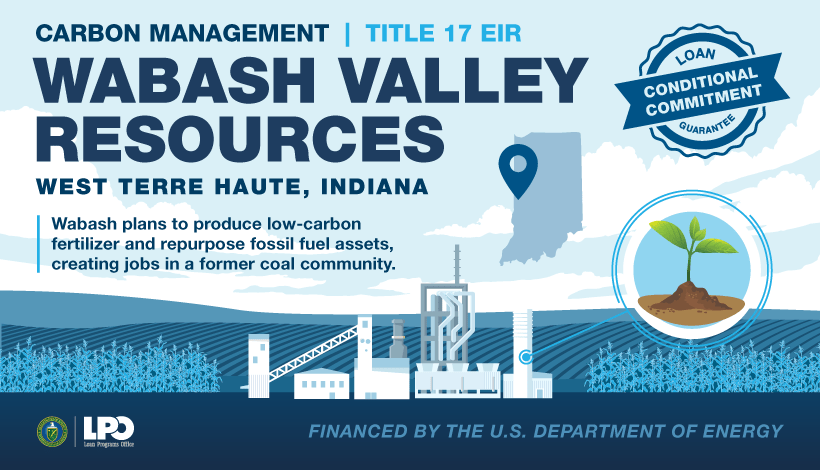The $1.559 billion would be part of a total investment of $2.4 billion that Wabash Valley Resources would secure for the project through private investment. (U.S. Department of Energy)
The U.S. Department of Energy announced Monday that it has made a conditional commitment for a loan guarantee of up to $1.559 billion to Wabash Valley Resources, LLC for a West Terre Haute fertilizer development.
“The project will have the potential to be the world’s first, carbon-negative ammonia production facility — underscoring the Biden-Harris Administration’s continued commitment to ensuring the United States leads the world in clean energy manufacturing,” a news release said.
Wabash Valley Resources (WVR) would be the first domestic producer located in the Corn Belt to produce low-carbon ammonia for local farmers and co-ops in the region.
WVR intends to pipe and inject 1.67 million tons of carbon dioxide annually a mile below the earth’s surface as part of its plan to produce “low-carbon-intensity” anhydrous ammonia fertilizer at a former coal gasification plant in Vigo County. Its permit allows it to build wells in Vermillion and Vigo counties.
Dan Williams, WVR’s chief operating officer, said “this close to a-decade-long development phase has been made possible through the dedicated efforts of the Department of Energy, the building trades unions, and our strategic partners. WVR is thrilled to be at the forefront of a new industrial era that harmonizes environmental, social, and economic benefits, and we cannot thank our partners enough.”
The $1.559 billion would be part of a total investment of $2.4 billion that WVR would secure for the project through private investment.
But the project hasn’t come without criticism. Residents have mobilized against it, citing potential consequences like pipe ruptures and water contamination. Many have been skeptical of the company’s intentions and its use of public incentives.
WVR aims to produce 500,000 metric tons of anhydrous ammonia annually.
The company says its product would be cost-competitive compared to existing ammonia imports, helping to drive down costs for local consumers and providing a stable, domestic fertilizer source. The market for ammonia can be volatile, subjecting farmers to price fluctuations. For instance, the Russian invasion of Ukraine significantly increased ammonia costs for U.S. farmers.
By using carbon sequestration, WVR would also be part of the country’s efforts to reduce agricultural industry emissions. The federal news release said ammonia-based fertilizer is a crucial element of the U.S. agricultural system, but its production is a significant contributor to climate change. Globally, ammonia manufacturing accounts for 1% to 2% of all CO2 emissions.
“Creating a large new source of anhydrous ammonia in Indiana would be of enormous benefit to Hoosier farmers. And, manufacturing fertilizer with a low carbon rating is even more powerful,” said Don Villwock, former president of Indiana Farm Bureau and a farmer in Edwardsport, Indiana.
The facility would also support hundreds of union jobs in West Terre Haute, according to the release.
GET THE MORNING HEADLINES DELIVERED TO YOUR INBOX

